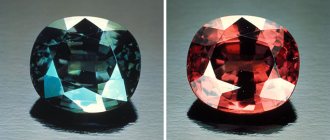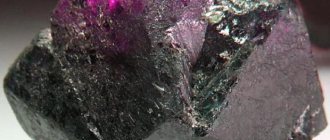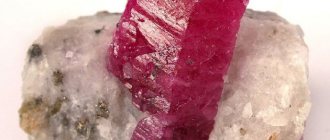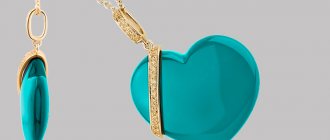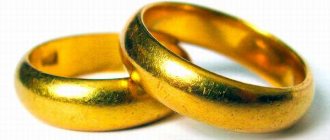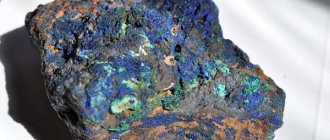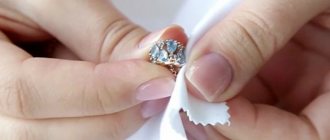Alexandrite? belongs to the chrysoberyl subspecies and is one of the rarest and most unique minerals. The first stone was found in the Urals in 1834, and was soon presented to Tsarevich Alexander on his 16th birthday. He did not take off the ring with the stone even when he became emperor, which is why the gem got its name - alexandrite, or imperial stone.
However, the mineral has another unofficial name - widow's stone. This is due to the fact that, imitating the emperor and his family, many noble ladies began to wear jewelry with alexandrite, but the war that began soon made most of them widows. It was then that tragic deaths began to be associated with the stone.
Mineral – Alexandrite
History of the gem
Alexandrite is a rare variety of the rare chrysoberyl gemstone. This makes it unique. The mineral changes color under different lighting conditions.
The world's first pebble was found in the Urals, brought to St. Petersburg and presented to Tsarevich Alexander when he came of age. Having become emperor, he did not remove the ring with the gem. Hence the second name of alexandrite – “imperial stone”.
However, the mineral has a reputation for being “widow’s”. This is because, imitating the royal family, noble ladies began to wear it. The First World War, which began soon, made many widows, which was attributed to jewelry with gems.
Classification by place of production
Raw materials are mined in different parts of the world, and in each mine the stones are special:
- The best in the world are Ural alexandrites: blue with green tints during the day, crimson in the evening, shimmering with purple. Olive-brown specimens are also found. The primary deposits have been exhausted, and only a few finds have been found.
- Crystals from Brazil, Madagascar, Africa - green with a brown tint during the day, dark red in the evening, shimmering with burgundy.
- Sri Lanka produces bluish-green nuggets with purple tints. The world's number one supplier.
Brazil is famous for its large alexandrites, but there are few of them.
Earrings with alexandrite
Alexandrite, sapphire, diamond, ruby, emerald are the five most expensive.
| Property | Description |
| Formula | Al2BeO4 |
| Color | In daylight: dark blue-green, bluish green, dark grass green, olive green. In evening or artificial light: pink-crimson, red-violet, purple. |
| Shine | Glass |
| Transparency | Transparent, translucent |
| Hardness | 8,5 |
| Cleavage | Imperfect |
| Kink | Conchoidal |
| Density | 3.5-3.84 g/cm³ |
Stone cost
The price of a stone is determined by size, color, depth of reverse (the ability to change color), purity.
The Ural gem with a purple or red tint is the most beautiful and expensive in the world, equal to diamonds ($20-35 thousand per carat).
Natural alexandrite larger than a carat is valued at $1 million per carat.
A more affordable variety is cat's eye (cymophane) - from $5 thousand per copy.
Gems with a slight degree of reverse and a dull grayish color are comparable in price to synthetics - $200-500 per carat.
A high-quality artificial stone is estimated at $400-500 per carat.
Jewelry with alexandrite
Alexandrite jewelry is divided into elite and public.
Premium segment
Products with alexandrite are made to order and sold at elite auctions. A ring or a pair of earrings with a natural stone can be exchanged for an island in the ocean.
Ring with alexandrite
In jewelry it is complemented with gems from the top five, often diamonds. To emphasize the beauty of the stone, it is combined with emerald and pearls, the luster of which is weaker than alexandrite.
The frame is made of platinum or gold of the highest standard.
Many jewelers reserve real alexandrite for collections without creating jewelry.
Public assortment
Alexandrite products in jewelry stores contain artificial gemstones. It is almost always framed in 925 silver.
The cost of jewelry is available (thousand rubles):
- silver ring – 7.2;
- silver earrings – 3.5;
- bracelet – 5.5;
- pendant – 1.2.
The price of gold (585°) jewelry with synthetic alexandrite is from 15.5 thousand rubles.
Who is the jewelry suitable for and how to wear it
Regardless of the origin of the stone, the rules of use are the same:
- The products are intended for women starting from adulthood.
- Gold earrings or other accessories are worn to social or formal events, silver jewelry is worn to the office. The wardrobe is appropriate: elegant for daytime or chic for evening.
- First, evaluate the shimmer of jewelry inserts in different lighting and outfits.
- Jewelry is suitable for any color type of appearance, especially good on green-eyed and brown-eyed housewives.
- Alexandrite is not worn en masse: one or two jewelry is enough.
Gold earrings with alexandrite
The stone is not prohibited for men, but in practice, men's accessories are rare.
For men
Men rarely wear alexandrite, although large rings made of platinum or white gold with a medium stone look incredibly expensive and respectable. In addition to rings and rings, cufflinks can be made to order with real stones. The prices for such products are incredibly high.
Jewelry with artificial stones can be purchased in jewelry stores or online; their prices are usually not very high.
- 750 gold ring with natural alexandrite and diamonds – RUB 1,500,000.
- Vintage silver ring with synthetic alexandrite 10.62x13.65 mm – RUB 5,300.
- Cufflinks made of rhodium-plated silver with synthetic alexandrite 15x12 mm – RUB 3,400.
Artificial alexandrite
Jewelry brands offer jewelry with artificial alexandrite.
Methods for obtaining synthetic stone:
- hydrothermal – the crystal is grown from scratch;
- refining - a semi-precious gem is saturated with chromium and vanadium.
The refined mineral is cheaper than the hydrothermal one.
The technology makes the analogue indistinguishable from a natural gem. It is brighter than the low-grade original, the color palette of tints is wider - from gray-blue to pink. There is no haze, cracks or inclusions. The parameters are set in advance.
All Soviet alexandrite jewelry has artificial stones inserted into it.
Synthetic alexandrite is faked. Instead, they offer artificial stones of a purple hue with an inconspicuous reverse, for example, spinel or corundum.
It is better to buy jewelry in stores or from dealers of the manufacturer who supplies them with documents.
Jewelry
The uniqueness of alexandrite primarily lies in its ability to change color depending on the lighting. For example, in daylight the stone can be green or blue, but in artificial light it changes to crimson. This effect is due to the presence of iron, chromium, titanium and vanadium in the mineral composition.
It is noteworthy that stones from different deposits have their own differences in color, so they can be divided into the following types:
- Ural - considered the most beautiful, its color palette changes from rich emerald green, less often olive brown, to red-violet;
- Indian - pale green-blue changes to violet-lilac;
- Sri Lankan - these stones are the most common, have a green-blue color during the day, changing to purple-brown in the evening;
- Brazilian - green during the day, changing to olive green towards the fan.
Jewelry with alexandrite is divided into public and premium segments. Elite products are made only to order or purchased at closed auctions. Jewelry is made from the best and most expensive types of gold and platinum, and alexandrite is often complemented with emerald, pearl, sapphire, ruby or diamond. The price of such products sometimes reaches several hundred thousand dollars, and even millions.
Also read: Jewelry with Beryl
Some jewelers keep alexandrite for their collection without making jewelry from it.
The publicly available assortment is represented by artificial stones framed in silver or gold; cubic zirconia is used as an addition. Artificial alexandrite is obtained in several ways:
- refining - the semi-precious stone is saturated with vanadium and chromium;
- hydrothermal - the mineral is grown entirely from scratch. Such a stone will cost more than a refined one.
Artificially grown gems are practically indistinguishable from natural ones, and sometimes even better - the color palette of tints is wider and brighter, there is no haze, inclusions or cracks on the stone.
Alexandrite is not used to make bracelets or necklaces - it is inserted into necklaces, rings, earrings and pendants.
Photo gallery of stone
Magical influence
Jewelry with natural gems is beneficial for the body:
- cleanses and strengthens blood vessels;
- improve the functioning of the gastrointestinal tract and nervous system;
- treat infectious diseases;
- The water in which the jewel has lain relieves alcoholism.
Alexandrite jewelry prolongs youth and life. But it is recommended to wear them during the day and take them off at night.
Earrings with alexandrite
For those who are put off by alexandrite's reputation as a "widow's stone", it is better to wear two pieces of jewelry or earrings.
Alexandrite jewelry is used as a talisman:
- people who are unable to control emotions and thoughts;
- those wishing to achieve unity with spiritual or otherworldly forces, to receive cosmic energy;
- gambling people who consider the gem a “magnet” of sudden wealth;
- confident in their creative potential: the stone will develop these abilities;
- In Europe, a ring with alexandrite is presented to inveterate jealous people or jealous people in order to cool their ardor.
The mineral “communicates” with its owner, changing color. If during the day a green-blue pebble turns brown and red for no reason, and turns green in the evening, problems are not far off. In serious cases, the gem changes color and turns yellow. If the color is emerald, good luck and happiness lie ahead.
According to the Zodiac, it is suitable for Gemini, Leo, Scorpio, Aquarius.
If you feel discomfort while wearing jewelry, it is better to sell it.
All this applies to natural stone.
An artificial gem has no magical or healing properties. However, there is no “widow’s”; it suits all signs of the Zodiac.
| Zodiac sign | Compatibility (“+++” – fits perfectly, “+” – can be worn, “-” – strictly contraindicated) |
| Aries | + |
| Taurus | — |
| Twins | +++ |
| Cancer | — |
| a lion | +++ |
| Virgo | — |
| Scales | + |
| Scorpion | + |
| Sagittarius | + |
| Capricorn | + |
| Aquarius | + |
| Fish | + |
Medicinal properties
Alexandrite is also valued for its medicinal properties:
- strengthens and cleanses blood vessels;
- treats infectious diseases;
- improves the functioning of the pancreas;
- normalizes the functioning of the gastrointestinal tract;
- calms the nervous system, fights insomnia and stress;
- serves as a prevention of skin diseases;
- lifts your mood and improves performance.
Water infused with alexandrite helps cure alcoholism. To do this, place the jewelry with the mineral in water and leave it overnight. You need to drink healing water every morning before breakfast until relief comes.
Lithotherapists believe that the stone works much more effectively during the day - it is better to remove it at night. In case of serious illnesses, constant wearing of alexandrite is also not recommended. Periodically you need to recharge the mineral - leave it overnight on a plate with salt, or in a container with spring water.
All the magical and healing effects described above apply only to natural, living stones. Artificially grown and simply fake stones do not have such properties.
Care instructions
Caring for jewelry is standard: protect from damage, impacts, remove for housework or make-up.
Ring and brooch with alexandrite
Dust is removed with a dry cloth and washed with warm water. It is better to take dirty jewelry to a jeweler for cleaning.
Store accessories in a cool, dark place, separate from others.
A natural or synthetic mineral emphasizes the status and financial capabilities of the owner, making her the center of attention.
For women
The range of women's jewelry includes rings, pendants, necklaces and earrings. They are also made to order, or options with artificial stone are available for free sale.
- Silver ring with natural alexandrite 13.14x9.34 mm – RUB 2,875,000.
- Ring made of 585 gold with artificial alexandrite and cubic zirconia – RUB 10,490.
- Vintage silver earrings with artificial alexandrite – RUB 5,500.
- Pendant with alexandrite in yellow gold – RUB 25,150.
Popular types of cuts
Alexandrite is mainly cut into oval, step or diamond teardrop cut. Cabochons are made from low purity stones with a “cat’s eye” effect.
Stone setting
For the setting of natural stone, platinum, white, red and yellow gold 750 are used.
Also read: Jewelry with Malachite
Artificial alexandrite is set in silver, rose and yellow gold of 585 assay value.
Stone compatibility
Alexandrite is a representative of Water, it will harmoniously combine with other water stones, as well as some representatives of Fire, equal to it in status:
- pearl;
- sapphire;
- opal;
- Moonstone;
- emerald;
- ruby;
- diamond.
Other Fire stones, as well as representatives of Air, do not combine with alexandrite at all:
- pomegranate;
- grossular;
- heliodor;
- amethyst;
- smoky and rose quartz;
- rhinestone;
- topaz;
- demantoid;
- uvarovite;
- amazonite
How to wear
The imperial stone is mainly worn for any events and social events. Silver jewelry with an artificial stone can be worn to a business meeting or to the office.
Alexandrite is mainly intended for women of middle or advanced age; men wear a ring with an expensive mineral less often.
In terms of appearance, the stone suits absolutely everyone, but it looks especially impressive on those with brown and green eyes.
Alexandrite is not worn in sets - 1-2 pieces of jewelry are enough.
How to care for jewelry
The stone must be protected from impacts and other damage. It does not tolerate household chemicals, cosmetics and high temperatures.
It is better to take dirty jewelry to a jeweler for cleaning; at home, the stone is simply washed periodically with warm water or wiped with a dry soft cloth.
Store jewelry with alexandrite in an individual box with soft cloth, separately from other jewelry and away from heating devices.
How to distinguish from a fake
Only artificial alexandrite is counterfeited, since the natural stone is so rare that it is impossible to buy it in a simple jewelry store.
They often try to pass off artificial stones of a lilac hue with faint tints - corundum, spinel, or ordinary painted glass - as a synthetic mineral.
